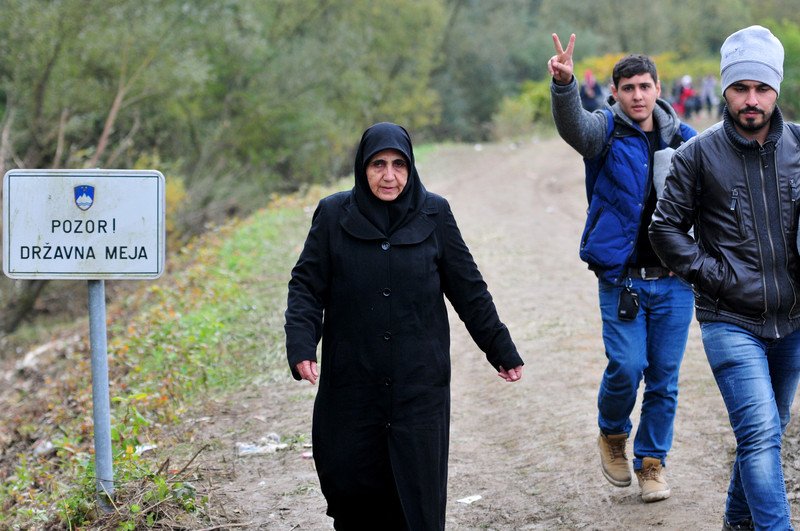This Friday, the National Assembly will hold an emergency meeting of the Committee on the Interior. At the end of the session, MPs will vote on three conclusions calling on the government to prepare a strategy for the mass import of migrants as soon as possible and to increase the asylum capacity to accommodate them. Such strategies have already failed abroad. Naive expectations of employment and integration of illegal migrants have turned into reports of mass unemployment and violence in the streets.
Tereza Novak, a member of the Freedom Movement party (Gibanje Svoboda), wrote in the convocation that the authorities in Slovenia are aware of the problem of “unregulated migration”, but that there is also a severe shortage of labour in Slovenia. “We need measures that will enable or facilitate access to human resources, and at the same time enable or facilitate their integration into society,” she wrote in the convocation.
She then further noted that the government has set up two working groups this year to prepare a migration and integration strategy. After both strategies are adopted, amendments to the Foreigners Act will follow. “The task of the Integration Working Group is to prepare a strategy for the integration of non-EU citizens into the cultural, economic and social life of Slovenia […] In preparing measures for effective integration, the Working Group focuses in particular on linguistic integration, integration in the fields of education, the labour market, the local community and cooperation with diasporas,” the strategy reads.
Integrations for lawbreakers
The government will, therefore, seek to integrate into Slovenian society individuals who have broken the law upon entry into our country. Slovenian legislation already lays down procedures for foreigners to enter the country legally for a variety of reasons, whether economic or personal. Many foreigners have found a home in Slovenia in this way, having in the past filled jobs for which there was no interest or simply not enough locals. In this way, they have co-created Slovenia. Unfortunately, integration has not always been successful. It is not uncommon for the descendants of immigrants to fail to identify with Slovenian identity, even on a declarative level.
The migration wave that happened in the years 2015 and 2016 turned what was more or less orderly migration beforehand on its head. At the southern national border, hordes of migrants appeared, without any documentation and with the desire to settle in Europe. The vast majority, as the convening of the meeting of the Committee on the Interior notes, showed no interest in settling in Slovenia. This is because it is unattractive from the point of view of economic opportunities and because of the low social transfers, if we compare them with those that could be received in Germany or Sweden. From 2013 to 2018, 1.2 million migrants entered Germany. In 2020, 48 percent of these newcomers were employed. 68 percent were in full-time or part-time jobs. Of these, 17 percent were in apprenticeships, 3 percent in paid traineeships, and 12 percent in small jobs or “marginal employment”, with a ceiling income of 520 euros or less per month. In Sweden, there have been reports of a sharp increase in gang violence in recent months. The violence has gotten so bad that the authorities have called on the army to intervene on the streets of the towns most affected by it.
A strategy that pragmatically welcomes illegal migrants on the basis of labour needs is, therefore, clearly wrong. It has failed in Germany, France, Sweden, and elsewhere. Low migrant employment, language barriers and poorly compatible cultures lead not to integration but to segregation. This could lead to the destabilisation of the European Union countries in the future through imported conflicts, inter-ethnic conflicts, terrorism and, ultimately, the rise of political movements that address citizens’ concerns that centre-left and left-wing political parties do not want to address. However, it is certainly possible to look for the missing workforce in more sensible ways, especially ways that open the door to Slovenia to those who are really needed, and not to random individuals who turn up illegally at our borders.
Because the government and the coalition made up of the Freedom Movement party, the Social Democrats (Socialni demokrati – SD) and the Left party (Levica) do not want to learn from examples we have seen abroad, calls of this kind are now being made:
- The Committee on the Interior, Public Administration and Local Self-Government proposes that the government adopts as soon as possible an integration strategy as part of its migration and integration policy, as well as a migration management strategy.
2. The Committee on the Interior, Public Administration and Local Self-Government proposes that the government, when finalising both strategies, take into account not only the international legal and humanitarian aspects, but also the serious shortage of labour in Slovenia.
3. The Committee on the Interior, Public Administration and Local Self-Government proposes that the government provide additional accommodation and care facilities for applicants for international protection as soon as possible.
Žiga Korsika


